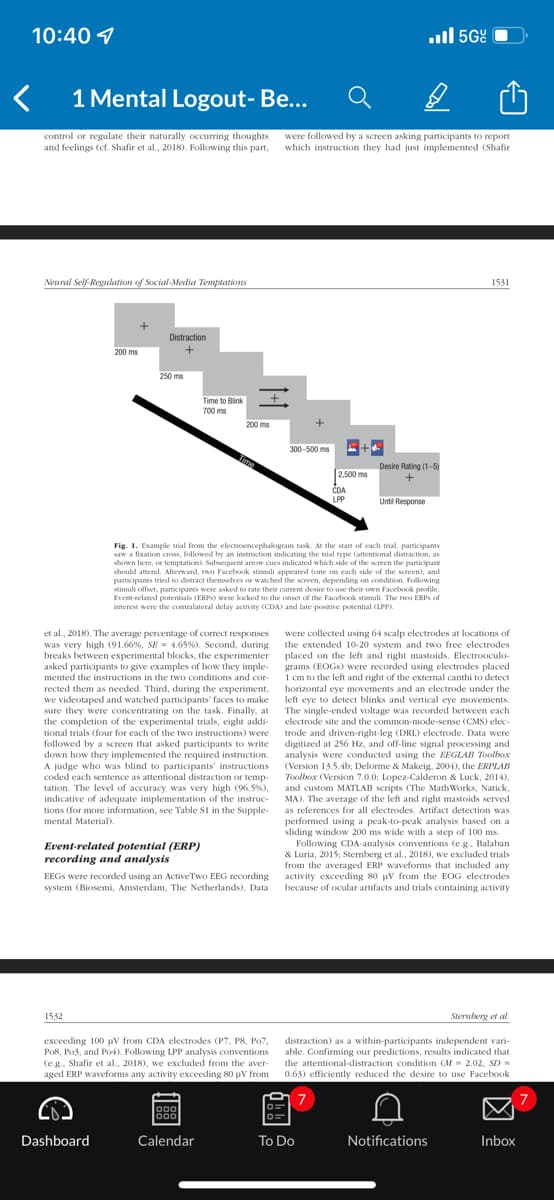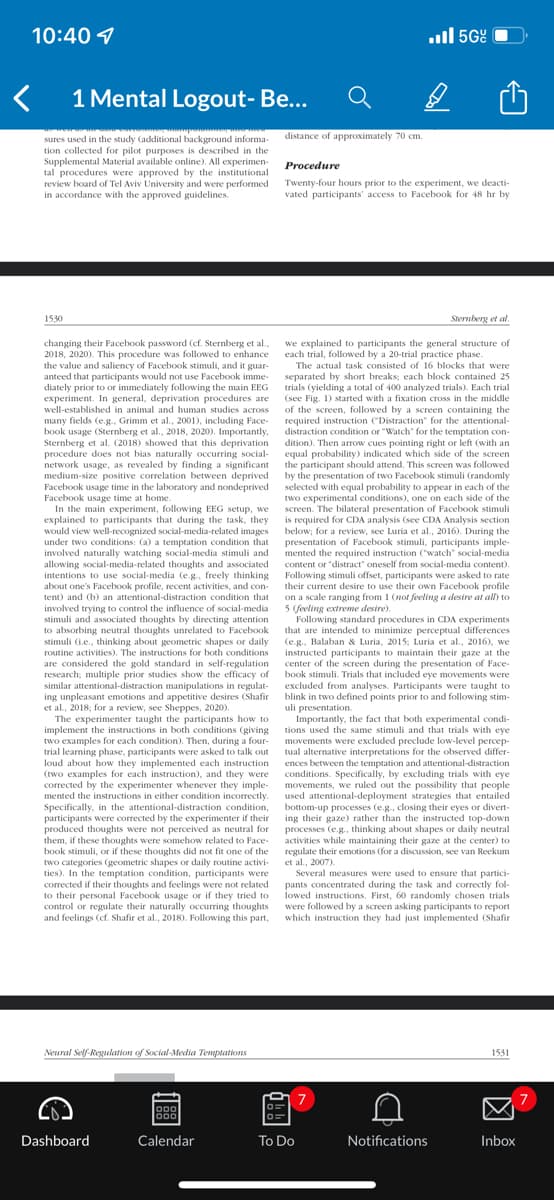Explain what the procedure is, what are the independent and dependent variables ? What experimental research did they use
Explain what the procedure is, what are the independent and dependent variables ? What experimental research did they use
Ciccarelli: Psychology_5 (5th Edition)
5th Edition
ISBN:9780134477961
Author:Saundra K. Ciccarelli, J. Noland White
Publisher:Saundra K. Ciccarelli, J. Noland White
Chapter1: The Science Of Psychology
Section: Chapter Questions
Problem 1TY
Related questions
Question
Explain what the procedure is, what are the independent and dependent variables ? What experimental research did they use ?

Transcribed Image Text:10:40
control or regulate their naturally occurring thoughts
and feelings (cf. Shafir et al., 2018). Following this part,
Neural Self-Regulation of Social-Media Temptations
1 Mental Logout- Be...
1532
200 ms
+
G
Distraction
+
250 ms
Event-related potential (ERP)
recording and analysis
Dashboard
et al., 2018). The average percentage of correct responses
was very high (91.66 %, SE 4.65%). Second, during
breaks between experimental blocks, the experimenter
asked participants to give examples of how they imple-
mented the instructions in the two conditions and cor-
rected them as needed. Third, during the experiment,
we videotaped and watched participants' faces to make
sure they were concentrating on the task. Finally, at
the completion of the experimental trials, eight addi-
tional trials (four for each of the two instructions) were
followed by a screen that asked participants to write
down how they implemented the required instruction.
A judge who was blind to participants' instructions.
coded each sentence as attentional distraction or temp-
tation. The level of accuracy was very high (96.5%),
indicative of adequate implementation of the instruc-
tions (for more information, see Table $1 in the Supple-
mental Material).
Time to Blink
700 ms
EEGS were recorded using an Active Two EEG recording
system (Biosemi, Amsterdam, The Netherlands). Data
200 ms
Time
exceeding 100 µV from CDA electrodes (P7, P8, Po7,
Po8, Po3, and Po4). Following LPP analysis conventions
(e.g., Shafir et al., 2018), we excluded from the aver-
aged ERP waveforms any activity exceeding 80 µV from
oool
Calendar
D
were followed by a screen asking participants to report
which instruction they had just implemented (Shafir
Fig. 1. Example trial from the electroencephalogram task. At the start of each trial, participants
saw a fixation cross, followed by an instruction indicating the trial type (attentional distraction, as
shown here, or temptation). Subsequent arrow cues indicated which side of the screen the participant
should attend. Afterward, two Facebook stimuli appeared (one on each side of the screen), and
participants tried to distract themselves or watched the screen, depending on condition. Following
stimuli offset, participants were asked to rate their current desire to use their own Facebook profile.
Event-related potentials (ERPs) were locked to the onset of the Facebook stimuli. The two ERPs of
interest were the contralateral delay activity (CDA) and late positive potential (LPP).
300-500 ms
2,500 ms
CDA
LPP
..5Gº
Desire Rating (1-5)
+
Until Response
To Do
were collected using 6-4 scalp electrodes at locations of
the extended 10-20 system and two free electrodes
placed on the left and right mastoids. Electrooculo-
grams (EOGs) were recorded using electrodes placed
1 cm to the left and right of the external canthi to detect
horizontal eye movements and an electrode under the
left eye to detect blinks and vertical eye movements.
The single-ended voltage was recorded between each
electrode site and the common-mode-sense (CMS) elec-
trode and driven-right-leg (DRL) electrode. Data were
digitized at 256 Hz, and off-line signal processing and
analysis were conducted using the EEGLAB Toolbox
(Version 13.5.4b; Delorme & Makeig, 2004), the ERPLAB
Toolbox (Version 7.0.0; Lopez-Calderon & Luck, 2014),
and custom MATLAB scripts (The MathWorks, Natick,
MA). The average of the left and right mastoids served
as references for all electrodes. Artifact detection was
performed using a peak-to-peak analysis based on a
sliding window 200 ms wide with a step of 100 ms.
1531
Following CDA-analysis conventions (e.g., Balaban
& Luria, 2015; Sternberg et al., 2018), we excluded trials
from the averaged ERP waveforms that included any
activity exceeding 80 µV from the EOG electrodes
because of ocular artifacts and trials containing activity
Notifications
distraction) as a within-participants independent vari-
able. Confirming our predictions, results indicated that
the attentional-distraction condition (M 2.02, SD =
0.63) efficiently reduced the desire to use Facebook
7
Sternberg et al.
Inbox
7

Transcribed Image Text:10:40
sures used in the study (additional background informa-
tion collected for pilot purposes is described in the
Supplemental Material available online). All experimen-
tal procedures were approved by the institutional
review board of Tel Aviv University and were performed
in accordance with the approved guidelines.
1530
1 Mental Logout- Be...
changing their Facebook password (cf. Sternberg et al.,
2018, 2020). This procedure was followed to enhance
the value and saliency of Facebook stimuli, and it guar-
anteed that participants would not use Facebook imme-
diately prior to or immediately following the main EEG
experiment. In general, deprivation procedures are
well-es
Il-established in animal and human studies across
many fields (e.g., Grimm et al., 2001), including Face-
book usage (Sternberg et al., 2018, 2020). Importantly,
Sternberg et al. (2018) showed that this deprivation
procedure does not bias naturally occurring social-
network usage, as revealed by finding a significant
medium-size positive correlation between deprived
Facebook usage time in the laboratory and nondeprived
Facebook usage time at home.
In the main experiment, following EEG setup, we
explained to participants that during the task, they
would view well-recognized social-media-related images
under two conditions: (a) a temptation condition that
involved naturally watching social-media stimuli and
allowing social-media-related thoughts and associated
intentions to use social-media (e.g., freely thinking
about one's Facebook profile, recent activities, and con-
tent) and (b) an attentional-distraction condition that
involved trying to control the influence of social-media
stimuli and associated thoughts by directing attention
to absorbing neutral thoughts unrelated to Facebook
stimuli (i.e., thinking about geometric shapes or daily
routine activities). The instructions for both conditions
are considered the gold standard in self-regulation
research; multiple prior studies show the efficacy of
similar attentional-distraction manipulations in regulat-
ing unpleasant emotions and appetitive desires (Shafir
et al., 2018; for a review, see Sheppes, 2020).
The experimenter taught the participants how to
implement the instructions in both conditions (giving
two examples for each condition). Then, during a four-
trial learning phase, participants were asked to talk out
loud about how they implemented each instruction.
(two examples for each instruction), and they were
corrected by the experimenter whenever they imple-
mented the instructions in either condition incorrectly.
Specifically, in the attentional-distraction condition,
participants were corrected by the experimenter if their
produced thoughts were not perceived as neutral for
them, if these thoughts were somehow related to Face-
book stimuli, or if these thoughts did not fit one of the
two categories (geometric shapes or daily routine activi-
ties). In the temptation condition, participants were
corrected if their thoughts and feelings were not related
to their personal Facebook usage or if they tried to
control or regulate their naturally occurring thoughts
and feelings (cf. Shafir et al., 2018). Following this part,
Neural Self-Regulation of Social-Media Temptations
G
Dashboard
188
Calendar
distance of approximately 70 cm.
Procedure
Twenty-four hours prior to the experiment, we deacti-
vated participants' access to Facebook for 48 hr by
B
Sternberg et al.
we explained to participants the general structure of
each trial, followed by a 20-trial practice phase.
..5Gº
The actual task consisted of 16 blocks that were
separated by short breaks; each block contained 25
trials (yielding a total of 400 analyzed trials). Each trial
(see Fig. 1) started with a fixation cross in the middle
of the screen, followed by a screen containing the
required instruction ("Distraction" for the attentional-
distraction condition or "Watch" for the temptation con-
dition). Then arrow cues pointing right or left (with an
equal probability) indicated which side of the screen
the participant should attend. This screen was followed
by the presentation of two Facebook stimuli (randomly
selected with equal probability to appear in each of the
two experimental conditions), one on each side of the
screen. The bilateral presentation of Facebook stimuli
is required for CDA analysis (see CDA Analysis section
below; for a review, see Luria et al., 2016). During the
presentation of Facebook stimuli, participants imple-
mented the required instruction ("watch" social-media
content or "distract" oneself from social-media content).
Following stimuli offset, participants were asked to rate
their current desire to use their own Facebook profile
on a scale ranging from 1 (not feeling a desire at all) to
5 (feeling extreme desire).
Following standard procedures in CDA experiments
that are intended to minimize perceptual differences.
(e.g., Balaban & Luria, 2015; Luria et al., 2016), we
instructed participants to maintain their gaze at the
center of the screen during the presentation of Face-
book stimuli. Trials that included eye movements were
excluded from analyses. Participants were taught to
blink in two defined points prior to and following stim-
uli presentation.
Importantly, the fact that both experimental condi-
tions used the same stimuli and that trials with eye
movements were excluded preclude low-level percep-
tual alternative interpretations for the observed differ-
ences between the temptation and attentional-distraction
conditions. Specifically, by excluding trials with eye
movements, we ruled out the possibility that people
used attentional-deployment strategies that entailed
bottom-up processes (e.g., closing their eyes or divert-
ing their gaze) rather than the instructed top-down
processes (e.g., thinking about shapes or daily neutral
activities while maintaining their gaze at the center) to
regulate their emotions (for a discussion, see van Reekum
et al., 2007).
To Do
Several measures were used to ensure that partici-
pants concentrated during the task and correctly fol-
lowed instructions. First, 60 randomly chosen trials
were followed by a screen asking participants to report
which instruction they had just implemented (Shafir
7
C
Notifications
1531
Inbox
Expert Solution
This question has been solved!
Explore an expertly crafted, step-by-step solution for a thorough understanding of key concepts.
This is a popular solution!
Trending now
This is a popular solution!
Step by step
Solved in 3 steps

Recommended textbooks for you

Ciccarelli: Psychology_5 (5th Edition)
Psychology
ISBN:
9780134477961
Author:
Saundra K. Ciccarelli, J. Noland White
Publisher:
PEARSON

Cognitive Psychology
Psychology
ISBN:
9781337408271
Author:
Goldstein, E. Bruce.
Publisher:
Cengage Learning,

Introduction to Psychology: Gateways to Mind and …
Psychology
ISBN:
9781337565691
Author:
Dennis Coon, John O. Mitterer, Tanya S. Martini
Publisher:
Cengage Learning

Ciccarelli: Psychology_5 (5th Edition)
Psychology
ISBN:
9780134477961
Author:
Saundra K. Ciccarelli, J. Noland White
Publisher:
PEARSON

Cognitive Psychology
Psychology
ISBN:
9781337408271
Author:
Goldstein, E. Bruce.
Publisher:
Cengage Learning,

Introduction to Psychology: Gateways to Mind and …
Psychology
ISBN:
9781337565691
Author:
Dennis Coon, John O. Mitterer, Tanya S. Martini
Publisher:
Cengage Learning

Psychology in Your Life (Second Edition)
Psychology
ISBN:
9780393265156
Author:
Sarah Grison, Michael Gazzaniga
Publisher:
W. W. Norton & Company

Cognitive Psychology: Connecting Mind, Research a…
Psychology
ISBN:
9781285763880
Author:
E. Bruce Goldstein
Publisher:
Cengage Learning

Theories of Personality (MindTap Course List)
Psychology
ISBN:
9781305652958
Author:
Duane P. Schultz, Sydney Ellen Schultz
Publisher:
Cengage Learning